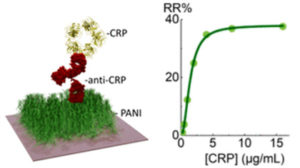A novel redox capacitive biosensor assay based on a phytic acid-doped PANI polymer

Figure 1 Schematic diagram and results of this method in an exemplary application using cardiac biomarker CRP
Applications: Molecule detection, molecule quantification, electrochemical impedance spectroscopy (EIS), capacitance spectroscopy, redox capacitance
| Features | Benefits |
|
|
|
|
|
|
|
|
Patented & available for:
- Licensing
- Co-development
- Consulting
Learn more – enquiries@innovation.ox.ac.uk
Browse more opportunities – www.innovation.ox.ac.uk
about this technology
© Oxford University Innovation

